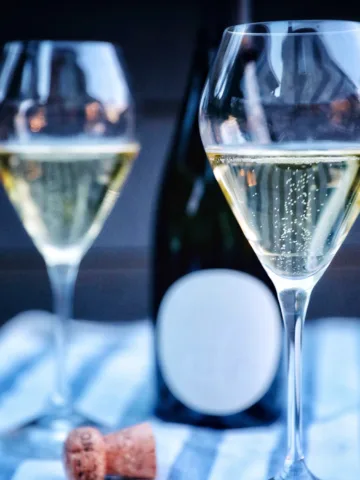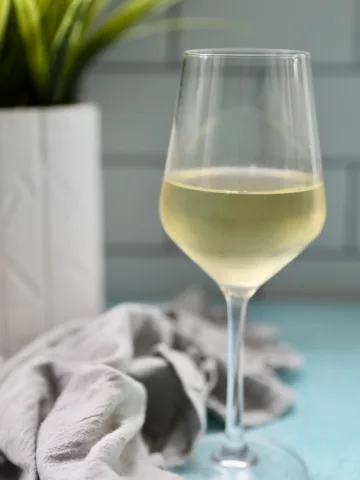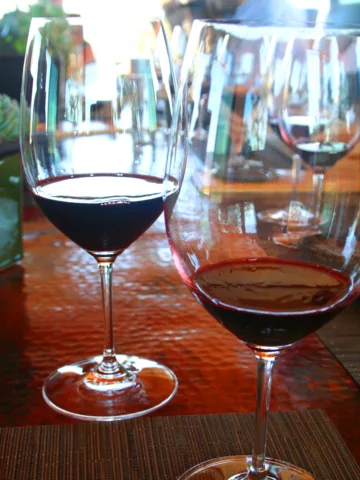These red wine grapes produce complex, full-bodied wines. But each has distinct characteristics that set them apart. Discover some of the main differences between Malbec vs Shiraz — from flavor and aroma profiles to ideal food pairings.

Both Malbec and Shiraz originally hail from France. But today, some of the best examples of these wines are produced in other countries: Argentina in the case of Malbec, and Australia for Shiraz. And that’s just one way these two red wine grapes are unique.
In this easy-to-use guide, I’ll cover the unique flavor and aroma characteristics of both Malbec and Shiraz, along with food pairing recommendations and average costs. Plus, I’ll reveal whether there’s a difference between Shiraz and Syrah.


Jump to:
What is Malbec?

Malbec is a robust red wine with a rich history. It’s believed to have originated in the Cahors region of France, where the first vines date back as far as the 1500s. But a phylloxera outbreak in the 19th century helped lay the groundwork for a Malbec epicenter in the New World.
That outbreak devasted many of the European Malbec vineyards, but the grape was soon introduced to Argentina, where it began to flourish, particularly in the high-altitude Mendoza region.
While France still produces excellent Malbec wines, Argentina now grows over 75% of the world’s Malbec grapes. These tend to be more fruit-forward and softer in tannins than French Malbec, which features more astringency.
In France, Malbec is used along with Cabernet Sauvignon, Cabernet Franc, Petit Verdot, and Merlot as a key grape in Bordeaux blends.
While Malbec is typically known for its rich purple hue, rose and white Malbecs are becoming increasingly popular — and are worth a try if you’re looking for something different to add to your wine repertoire.

Apart from Argentina and France, Malbec is grown in the United States (particularly in California and Southern Oregon), New Zealand, and Chile.
What is Shiraz?
Shiraz is a full-bodied red wine rich in tannins, with a deep ruby red to purple color. Like Malbec, the grape that produces Shiraz also hails from France, where it’s called Syrah. The Syrah grape has its roots along France’s Northern Rhône valley and gained popularity in Europe in the 18th century.
In the 19th century, it was brought to Australia, where it was referred to as “Shiraz.” It’s unclear how the term originated there, but it stuck. Now Australia accounts for a large portion of global Shiraz (but not Syrah) production.
The Syrah and Shiraz grapes thrive in moderate to warm climates and are now among the most widely planted wine grape varieties in the world. Along with France and Australia, it is widely planted in South America and the United States — especially Washington State and California.
What’s the difference between Shiraz and Syrah?
Let’s clear up the confusion between Shiraz and Syrah. Both terms are interchangeable to the extent that they refer to wines made from the same grape variety. The difference has to do with where they are grown.
Many winemakers will refer to a wine as Shiraz if it’s produced in a warmer climate. On the other hand, those from moderate climates are typically called Syrahs.
Therefore, in areas like France and the United States, the grape and the wine are largely called Syrah. In Australia and South Africa, which generally feature warmer growing climates, it’s commonly referred to as Shiraz.
So while both terms refer to a style of wine using the Syrah grape, Shiraz and Syrah can exhibit slightly different wine characteristics and flavor profiles, which we’ll cover in more detail below.
Note – It was previously speculated that Shiraz originated near the city of the same name in Persia — modern-day Iran. But DNA analysis has since proven its French origin. While the area of Shiraz in Iran was also known for wine, it was a separate style.
Malbec flavor profile
A word often used to describe Malbec is “jammy.” These wines have a prominent grape-forward taste, with dark fruit notes including blackberry and plum. Black pepper, vanilla, chocolate, and leather are also common Malbec flavor characteristics.
In terms of aroma, you’ll often sense notes of blueberry and black cherry with Malbecs — a nice contrast to the dark fruit flavors which can help make these wines smell and feel lighter than other bold reds like Cabernet Sauvignons or Syrahs.
Generally with moderate tannins to high tannins, Malbecs are dry wines with a medium finish and acidity. Their alcohol level typically ranges from about 13% to 14.5% ABV.
Shiraz flavor profile

Shiraz (and Syrah) wines have lots of structure, and they get their high tannins in part due to the thick-skinned grape used to make them. That can result in wines that feel grippy or even chewy. But those tannins typically mellow out over time to produce wines that are elegant and smooth, making them a favorite among wine enthusiasts.
Flavor notes of plum and blueberry are common, as are peppercorn, black pepper, truffles, and smoke.
Australian Shiraz tends to be more tannic and fruit-forward than Syrah. That has to do with the sunny climates where Shiraz is grown, which allow the fruit to ripen more fully.
Syrah and Shiraz can also differ when it comes to acidity. Syrah varietal wine made in cooler climates often has brighter, higher acidity with more tartness. Shiraz from warmer climates tends to have moderate acidity.
Climate also affects the alcohol levels in these wine styles. Warm region Shiraz wine will have a higher average ABV — 14% to 15.5%. These grapes ripen longer on the vine, resulting in greater sugar levels (which means more alcohol created during fermentation). Cooler climate Syrahs will fall somewhere in the 13–14.5% ABV range.
Malbec food pairings
If you like steak, Malbec is a good choice for leaner cuts of meat like filet mignon and hanger steak. It can also be an ideal pairing for game birds or game meats like duck or venison. Roasted salmon, mushrooms, and creamier cheeses like blue cheese and gorgonzola also pair well with Malbec.

Shiraz and Syrah food pairings
Red meat is a classic pairing for Shiraz and Syrah. Steak cuts that are higher in fat like Rib Eye or New York Strip are great choices as the tannins will complement the richness of the meat and bring out the wine’s intense flavors and aromas.
Roasted duck, lamb, BBQ ribs, and burgers are also good meat pairings. Additionally, rich red sauce pasta dishes and mushrooms go well with Shiraz. For cheese, choose harder, flavorful varieties like gouda, gruyere, or asiago, which will hold up to the bold flavors in the wine.
Price
If you’re new to Malbec, you can start trying them without breaking the bank. Good bottles can be widely found starting at around $15 and are generally ready to drink without aging. However, some Malbecs will age very well for anywhere between 5 and 20 years depending on the quality, and if kept in a temperature-controlled setting.
A ready-to-drink bottle of Syrah and Shiraz will generally fetch around $20 and up. Though you can easily spend more than $100 for a high-quality bottle of either. The high tannins in these wines make them ideal for long-term aging. Most will age well for 5-10 years. Some fuller-bodied Shiraz and Syrah wine can age even longer, up to 20 years.
Shiraz vs Malbec summary
Shiraz/Syrah
- Primary growing regions: France, United States, Australia (Shiraz)
- Worldwide growing acres: 470,000
- Body: Medium to full
- Color: Deep red to deep purple
- Acidity: Medium
- Tannins: High
- Flavor notes: Black fruit, plum, blueberry, peppercorn, truffles, and smoke
- Cost: $15-$20 to start; $25 and up for higher quality
Malbec
- Primary growing regions: Argentina, France
- Worldwide growing acres: 106,000
- Body: Full to medium
- Color: Deep purple
- Acidity: Medium
- Tannins: Moderate to high
- Flavor notes: Plum, blackberry, blueberry, black cherry, jam, and leather
- Cost: $15 and up. Generally more affordable than other full-bodied red wines.
More wine tasting guides
Discover more wines with these easy-to-follow wine guides.






Leave a Reply